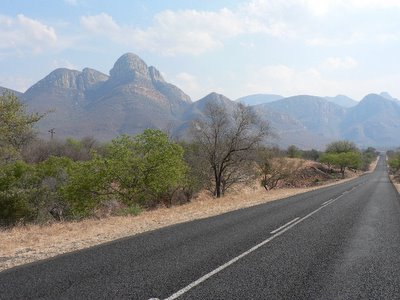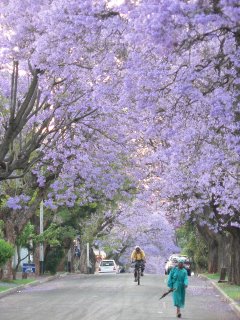Maputo
 Thomas and I took the overnight bus to Maputo last weekend for some good espresso and a brief immersion into the warmth and bustle of Mozambique's capital city. Getting there was a highlight: we left Pretoria in the evening and arrived at the border about 4am with urgent instructions from our driver to get in and out of the South Africa departure building as quickly as possible, don't wait for the bus (which was stuck in gridlock with the other pre-dawn border crossers), walk the 500m to the Mozambican side and find someone to give us a visa (we were the only ones on the bus that needed one, hence the special attention lest we keep everyone else waiting). “Don't wait in any lines!”
Thomas and I took the overnight bus to Maputo last weekend for some good espresso and a brief immersion into the warmth and bustle of Mozambique's capital city. Getting there was a highlight: we left Pretoria in the evening and arrived at the border about 4am with urgent instructions from our driver to get in and out of the South Africa departure building as quickly as possible, don't wait for the bus (which was stuck in gridlock with the other pre-dawn border crossers), walk the 500m to the Mozambican side and find someone to give us a visa (we were the only ones on the bus that needed one, hence the special attention lest we keep everyone else waiting). “Don't wait in any lines!”All South African departure offices I have been to are cunningly designed to create the greatest amount of conjestion with the minimum number of people. The layout is simple: a long narrow hallway with kiosks down one side; if you line more than two people up in front of any given window you will hit the opposite wall, after which it's a free for all. Thomas and I were soon to learn, however, that in comparison to the Mozambican system, South African immigration was the height of rationality and civility.
As per our instructions, Thomas and I hastily got our stamp on the South Africa side and proceeded to Mozambique where, ignoring the huge line up outside, we headed straight into the first building we came to, elbows first. Inside: chaos! Identify the most promising looking counter, push to the front, grab a slip of paper, find someone with a pen, beg them for it. Fill out the form whilst, with feet placed firmly on the ground, you try not to get pushed too far back from the counter, take a handful of cash, hand it back with your passport. Wait 10 minutes while someone looks it over in a back room. Make vaguely insulting comments at some guy who manages to get instant service by calling the lady behind the counter “mama” and handing her 4 or 5 passports. Maintain a brave face when he tells you he works for the government and I shouldn't “be stupid.” Retrieve passports and run, trimphantly, back to the bus which has also, in the meantime, managed to cross the border. What a rush!
Maputo itself was great. I'm not going to give you a history lesson because I didn't have a chance to learn anything before going, unfortunately. Mozambique is a former Portuguese colony, this is still the only official language, and it makes for a very different cultural experience to that in SA. Like I said, we drank lots of delicious espresso (and plenty of pastries too). Saw much of the city on foot, which was quite exhausting from the combination of heat, humidity and sleep deprivation. Got a little overwhelmed by the zealous sellers at the market, but loved chattering back at them in Portuguese. Listened to some really nice jazz on a platform of the old train station. Had my first combi ride (combis are the once informal, now formal “black” taxis that substitute for a proper public transit system in these parts - ubiquitous in Pretoria, but I never use them here) - seat 11, fit 25. Bought calamari and prawns at the fish market and had them cooked up for us at one of the neighbouring restaurants. Got back on the bus Sunday evening and headed home. Arrived back around 5:30 - time for an hour in my bed before going to work.
Maputo is bursting with character. The streets are full of people selling things, friends hanging out, the richer folk sipping espresso and eating pastries in good European fashion. Red “flame” trees - similar to the purple jacaranda in Pretoria - add colour and shade. The streets are potholed and litter-strewn. The shopping is hectic (the decibles really go up when it becomes known you can understand a little Portuguese). The sun is hot.
I almost forgot - the street names! It's despicable, but little wonder the Apartheid regime in South Africa was tolerated for so long by the communist-fearing West: Ho Chi Minh Ave. and Friedrich Engels Street; Lenin Ave was one of the main roads. There is a Robert Mugabe square (actually he was a big fan of the West, wasn’t he?). And the two backpackers in town are on Mao Tse Tung and Patrice Lumuba Streets. Truly, I didn't see a street that didn't commemorate one socialist brother or another.
A word about the photos: many of them were shot “from the hip,” which is a little trick Lisa taught me. In other words I wasn't looking through the lens when I took the shots (I took the pictures sideways as I was walking down the street). I'm not sure yet about this approach - aside from the fact that most of the shots are pretty lousy, I'm photographing people without them knowing it, and I'm not sure how cool this is. The great thing about it, of course, is that you get photos of people who don't know they're having their photo taken, and the few that did turn out ok capture “the street” much better than I could otherwise have hoped. In any case, I hope you like them. This was my last adventure before coming home, sadly, and I really tried to soak up as much as I could. I'm homeward bound in less than two weeks!
Photos are here.






